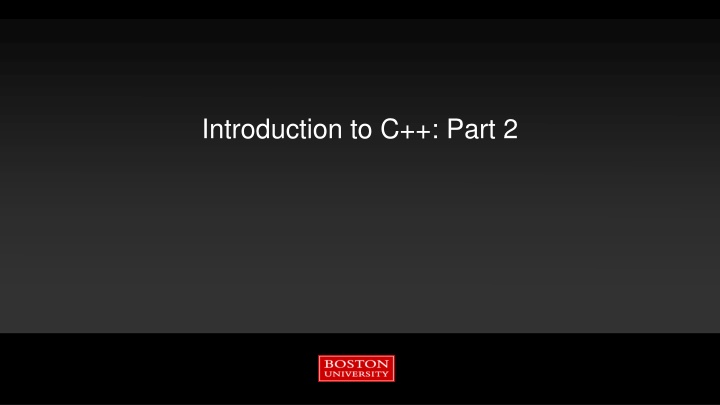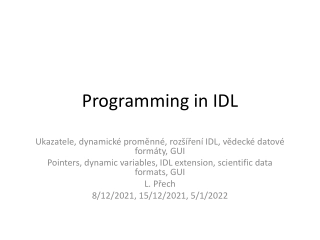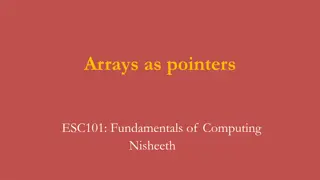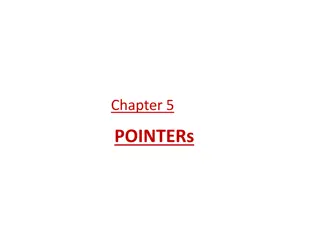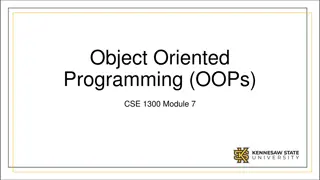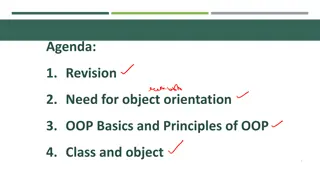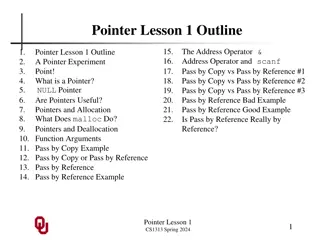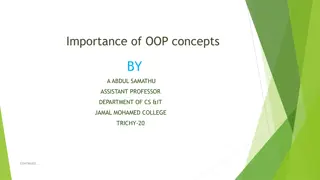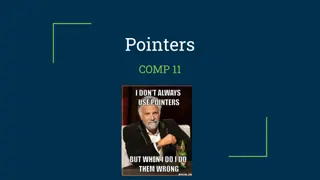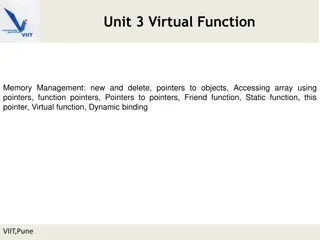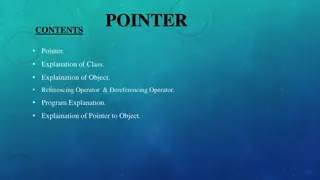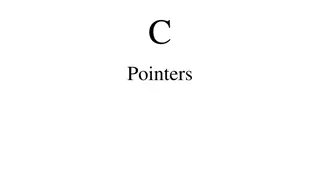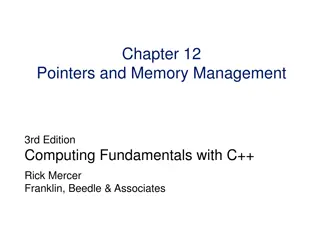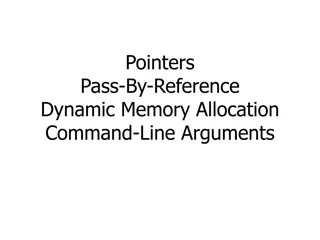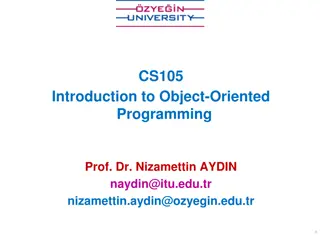Introduction to C++: Part 2 - References, Pointers, and OOP Concepts
Part 2 of the C++ tutorial delves into references and pointers, essential concepts for managing memory addresses and values. Learn about passing by reference, manipulating pointers, and formal object-oriented programming (OOP) concepts like inheritance, abstraction, and encapsulation. Discover when to use references or pointers and how they can improve memory management and performance in your C++ programs.
Uploaded on Mar 15, 2025 | 1 Views
Download Presentation

Please find below an Image/Link to download the presentation.
The content on the website is provided AS IS for your information and personal use only. It may not be sold, licensed, or shared on other websites without obtaining consent from the author.If you encounter any issues during the download, it is possible that the publisher has removed the file from their server.
You are allowed to download the files provided on this website for personal or commercial use, subject to the condition that they are used lawfully. All files are the property of their respective owners.
The content on the website is provided AS IS for your information and personal use only. It may not be sold, licensed, or shared on other websites without obtaining consent from the author.
E N D
Presentation Transcript
Tutorial Outline: Parts 2 and 3 References and Pointers The formal concepts in OOP More about C++ classes Inheritance, Abstraction, and Encapsulation Virtual functions and Interfaces
References and Pointers Part 1 introduced the concept of passing by reference when calling functions. Selected by using the & character in function argument types: int add (int &a, int b) References hold a memory address of a value. int add (int &a, int b) a has the value of a memory address, b has an integer value. Used like regular variables and C++ automatically fills in the value of the reference when needed: int c = a + b ; retrieve the value of a and add it to the value of b From C there is another way to deal with the memory address of a variable: via pointer types. Similar syntax in functions except that the & is replaced with a *: int add (int *a, int b) To get a value a pointer requires manual intervention by the programmer: int c = *a + b ; retrieve the value of a and add it to the value of b
Reference Pointer int a = 0 ; Declaration int &ref ; int *ptr ; int &ref = a ; Set memory address to something in memory int a = 0 ; int &ref = a ; int a = 0 ; int *ptr = &a ; int *ptr = &a ; Fetch value of thing in memory cout << ref ; cout << *ptr ; Can refer/point to nothing (null value)? No Yes int a: 4 bytes in memory at address 0xAABBFF with a value of 0. Can change address that it refers to/points at? No. Yes int a = 0 ; int b = 1 ; int &ref = a ; ref = b ; // value of a is now 1! int a = 0 ; int b = 1 ; int *ptr = &a ; ptr = &b ; // ptr now points at b Value stored in ref: 0xAABBFF Object member/method syntax MyClass obj ; obj &ref = obj ; MyClass obj ; obj *ptr = obj ; ptr->member ; ptr->method(); ref.member ; ref.method(); Value stored in ptr: 0xAABBFF // OR (*ptr).member ; (*ptr).method() ;
When to use a reference or a pointer Bother references and pointers can be used to refer to objects in memory in methods, functions, loops, etc. Avoids copying due to default call-by-value C++ behavior Could lead to memory/performance problems. Or cause issues with open files, databases, etc. If you need to: Hold a null value (i.e. point at nothing), use a pointer. Re-assign the memory address stored, use a pointer. Otherwise, use a reference. References are much easier to use, no funky C-style pointer syntax. Same benefits as a pointer, with less chance for error. Also no need to check if a reference has a null value since they can t. void add(const int *a, const int b, int *c) { if (a) { // check for null pointer *c = *a + b ; } }
The formal concepts in OOP Object-oriented programming (OOP): Defines classes to represent data and logic in a program. Classes can contain members (data) and methods (internal functions). Creates instances of classes, aka objects, and builds the programs out of their interactions. The core concepts in addition to classes and objects are: Encapsulation Inheritance Polymorphism Abstraction Polymorphism Encapsulation OOP Inheritance Abstraction
Core Concepts Encapsulation As mentioned while building the C++ class in the last session. Bundles related data and functions into a class Abstraction The hiding of members, methods, and implementation details inside of a class. Polymorphism The application of the same code to multiple data types There are 3 kinds, all of which are supported in C++. However only 1 is actually called polymorphism in C++ jargon (!) Inheritance Builds a relationship between classes to share class members and methods
#ifndef RECTANGLE_H #define RECTANGLE_H C++ Classes Open the Part 2 Shapes project in C::B In the Rectangle class C::B generated two methods automatically. Rectangle() is a constructor. This is a method that is called when an object is instantiated for this class. Multiple constructors per class are allowed ~Rectangle() is a destructor. This is called when an object is removed from memory. Only one destructor per class is allowed! (ignore the virtual keyword for now) class Rectangle { public: Rectangle(); virtual ~Rectangle(); float m_length ; float m_width ; float Area() ; protected: private: }; #endif // RECTANGLE_H
Encapsulation Bundling the data and area calculation for a rectangle into a single class is and example of the concept of encapsulation.
Construction and Destruction The constructor is called when an object is created. This is used to initialize an object: Load values into member variables Open files Connect to hardware, databases, networks, etc. The destructor is called when an object goes out of scope. Example: void function() { ClassOne c1 ; } Object c1 is created when the program reaches the first line of the function, and destroyed when the program leaves the function.
When an object is instantiated #include "rectangle.h" int main() { Rectangle rT ; rT.m_width = 1.0 ; } The rT object is created in memory. When it is created its constructor is called to do any necessary initialization. Here the constructor is empty so nothing is done. The constructor can take any number of arguments like any other function but it cannot return any values. Essentially the return value is the object itself! What if there are multiple constructors? The compiler chooses the correct one based on the arguments given. #include "rectangle.h" Rectangle::Rectangle() { //ctor } Note the constructor has no return type!
A second constructor #include "rectangle.h" /* OK to do this */ Rectangle::Rectangle(float width, float length) { m_width = width ; m_length = length ; } rectangle.h class Rectangle { public: rectangle.cpp Rectangle(); Rectangle(float width, float length) ; /* etc */ }; OR #include "rectangle.h /* Better to do this */ Rectangle::Rectangle(float width, float length) : m_width(width),m_length(length) { } Two styles of constructor. Above is the C++11 member initialization list style. At the top is the old way. C++11 is preferred. With the old way the empty constructor is called automatically even though it does nothing it still adds a function call. Same rectangle.h for both styles.
Member Initialization Lists Syntax: Colon goes here MyClass(int A, OtherClass &B, float C): m_A(A), m_B(B), m_C(C) { /* other code can go here */ } Members assigned and separated with commas. Note: order doesn t matter. Additional code can be added in the code block.
And now use both constructors #include <iostream> using namespace std; Both constructors are now used. The new constructor initializes the values when the object is created. Constructors are used to: Initialize members Open files Connect to databases Etc. #include "rectangle.h" int main() { Rectangle rT ; rT.m_width = 1.0 ; rT.m_length = 2.0 ; cout << rT.Area() << endl ; Rectangle rT_2(2.0,2.0) ; cout << rT_2.Area() << endl ; return 0; }
#ifndef RECTANGLE_H #define RECTANGLE_H Default values class Rectangle { public: C++11 added the ability to define default values in headers in an intuitive way. Pre-C++11 default values would have been coded into constructors. If members with default values get their value set in constructor than the default value is ignored. i.e. no double setting of the value. Rectangle(); virtual ~Rectangle(); // could do: float m_length = 0.0 ; float m_width = 0.0 ; float Area() ; protected: private: }; #endif // RECTANGLE_H
Using the C::B Debugger To show how this works we will use the C::B interactive debugger to step through the program line-by-line to follow the constructor calls. Make sure you are running in Debug mode. This turns off compiler optimizations and has the compiler include information in the compiled code for effective debugging.
Add a Breakpoint Breakpoints tell the debugger to halt at a particular line so that the state of the program can be inspected. In rectangle.cpp, double click to the left of the lines in the constructors to set a pair of breakpoints. A red dot will appear. Click the red arrow to start the code in the debugger.
The program has paused at the first breakpoint in the default constructor. Use the Next Line button to go back to the main() routine. Press the red arrow to continue execution stops at the next breakpoint.
Default constructors and destructors The two methods created by C::B automatically are explicit versions of the default C++ constructors and destructors. You must define your own constructor when you want to initialize an object with arguments (as done here) Every class has them if you don t define them then empty ones that do nothing will be created for you by the compiler. If you really don t want the default constructor you can delete it with the delete keyword. Also in the header file you can use the default keyword if you like to be clear. A custom destructor is always needed when internal members in the class need special handling. Examples: manually allocated memory, open files, hardware drivers, database or network connections, custom data structures, etc.
Note the destructor has no return type and is named with a ~. This class just has 2 floats as members which are automatically removed from memory by the compiler. Destructors Destructors are called when an object is destroyed. There is only one destructor allowed per class. Objects are destroyed when they go out of scope. Destructors are never called explicitly by the programmer. Calls to destructors are inserted automatically by the compiler. Rectangle::~Rectangle() { //dtor } ~House() destructor House object
Scope Scope is the region where a variable is valid. Constructors are called when an object is created. Destructors are only ever called implicitly. int main() { // Start of a code block // in main function scope float x ; // No constructors for built-in types ClassOne c1 ; // c1 constructor ClassOne() is called. if (1){ // Start of an inner code block // scope of c2 is this inner code block ClassOne c2 ; //c2 constructor ClassOne() is called. } // c2 destructor ~ClassOne() is called. ClassOne c3 ; // c3 constructor ClassOne() is called. } // leaving program, call destructors for c3 and c1 ~ClassOne() // variable x: no destructor for built-in type
Copy, Assignment, and Move Constructors The compiler will automatically create constructors to deal with copying, assignment, and moving. Moving occurs, for example, when an object is created and added to a list in a loop. Moving is an optimization feature that s part of C++11. Dealing with the details of these constructors is outside of the scope of this tutorial How do you know if you need to write one? When you move, assign, or copy an object in your code and the code won t compile! OR you move, assign, or copy an object, it compiles, but unexpected things happen when running. You may require custom code when... dealing with open files inside an object The class manually allocated memory Hardware resources (a serial port) opened inside an object Etc. Rectangle rT_1(1.0,2.0) ; // Now use the copy constructor Rectangle rT_2(rT_1) ; // Do an assignment, with the // default assignment operator rT_2 = rT_1 ;
So Far Define a C++ class Adding members and methods Use separate header and source files for a C++ class. Class constructors & destructors OOP concept: Encapsulation
The formal concepts in OOP Polymorphism Next up: Inheritance Encapsulation OOP Inheritance Abstraction
Inheritance Inheritance is the ability to form a hierarchy of classes where they share common members and methods. Helps with: code re-use, consistent programming, program organization Molecule This is a powerful concept! Inorganic Organic Mineral Protein
Inheritance Superclass Base Class The class being derived from is referred to as the base, parent, or super class. Molecule The class being derived is the derived, child, or sub class. Subclass For consistency, we ll use superclass and subclass in this tutorial. A base class is the one at the top of the hierarchy. Inorganic Organic Mineral Protein
Inheritance in Action Streams in C++ are series of characters the C+ I/O system is based on this concept. cout is an object of the class ostream. It is a write-only series of characters that prints to the terminal. There are two subclasses of ostream: ofstream write characters to a file ostringstream write characters to a string Writing to the terminal is straightforward: cout << some_variable ; How might an object of class ofstream or ostringstream be used if we want to write characters to a file or to a string?
Inheritance in Action For ofstream and ofstringstream the << operator is inherited from ostream and behaves the same way for each from the programmer s point of view. The ofstream class adds a constructor to open a file and a close() method. ofstringstream adds a method to retrieve the underlying string, str() If you wanted a class to write to something else, like a USB port Maybe look into inheriting from ostream! Or its underlying class, basic_ostreamwhich handles types other than characters
Inheritance in Action #include <iostream> // cout #include <fstream> // ofstream #include <sstream> // ostringstream using namespace std ; void some_func(string msg) { cout << msg ; // to the terminal // The constructor opens a file for writing ofstream my_file("filename.txt") ; // Write to the file. my_file << msg ; // close the file. my_file.close() ; ostringstream oss ; // Write to the stringstream oss << msg ; // Get the string from stringstream cout << oss.str() } ;
Single vs Multiple Inheritance A C++ supports creating relationships where a subclass inherits data members and methods from a single superclass: single inheritance C++ also support inheriting from multiple classes simultaneously: Multiple inheritance This tutorial will only cover single inheritance. Generally speaking Multiple inheritance requires a large amount of design effort It s an easy way to end up with overly complex, fragile code Java, C#, and Python (all came after C++) exclude multiple inheritance on purpose to avoid problems with it. C B D With multiple inheritance a hierarchy like this is possible to create. This is nicknamed the Deadly Diamond of Death as it creates ambiguity in the code. We will briefly address creating interfaces in C++ later on which gives most of the desired functionality of multiple inheritance without the headaches. There are only two things wrong with C++: The initial concept and the implementation. Bertrand Meyer (inventor of the Eiffel OOP language)
Public, protected, private class Rectangle { public: These keywords were added by C::B to our Rectangle class. Rectangle(); Rectangle(float width, float length) ; virtual ~Rectangle(); float m_width ; float m_length ; These are used to control access to different parts of the class during inheritance by other pieces of code. float Area() ; protected: private: };
C++ Access Control and Inheritance A summary of the accessibility of members and methods: Access public protected private Same class Yes Yes Yes Subclass Yes Yes No Outside classes Yes No No Inheritance class Super { public: int i; protected: int j ; private: int k ; }; class Sub : public Super { // in methods, could access // i and k from Parent only. }; Outside code Sub myobj ; Myobj.i = 10 ; // ok Myobj.j = 3 ; // Compiler error
Abstraction Having private (internal) data and methods separated from public ones is the OOP concept of abstraction.
C++ Inheritance Syntax Inheritance syntax pattern: class SubclassName : public SuperclassName class Super { public: int i; protected: int j ; private: int k ; }; Here the public keyword is used. Methods implemented in class Sub can access any public or protected members and methods in Super but cannot access anything that is private. Other inheritance types are protected and private. class Sub : public Super { // ... };
It is now time to inherit The C::B program will help with the syntax when defining a class that inherits from another class. With the Shapes project open, click on File New Class Give it the name Square and check the Inherits another class option. Enter Rectangle as the superclass and the include as rectangle.h (note the lowercase r) Click Create!
square.cpp square.h #ifndef SQUARE_H #define SQUARE_H #include "square.h" Square::Square() { //ctor } #include "rectangle.h" class Square : public Rectangle { public: Square(); virtual ~Square(); Square::~Square() { //dtor } protected: Note that subclasses are free to add any number of new methods or members, they are not limited to those in the superclass. private: }; #endif // SQUARE_H 2 files are automatically generated: square.h and square.cpp Class Square inherits from class Rectangle
A new constructor is needed. A square is, of course, just a rectangle with equal length and width. The area can be calculated the same way as a rectangle. Our Square class therefore needs just one value to initialize it and it can re-use the Rectangle.Area() method for its area. Go ahead and try it: Add an argument to the default constructor in square.h Update the constructor in square.cpp to do ? Remember Square can access the public members and methods in its superclass
Solution 1 #ifndef SQUARE_H #define SQUARE_H #include "square.h" Square::Square(float length) : m_width(width), m_length(length) {} #include "rectangle.h" class Square : public Rectangle { public: Square(float width); virtual ~Square(); Square can access the public members in its superclass. Its constructor can then just assign the length of the side to the Rectangle m_width and m_length. protected: This is unsatisfying while there is nothing wrongwith this it s not the OOP way to do things. private: }; #endif // SQUARE_H Why re-code the perfectly good constructor in Rectangle?
The delegating constructor C++11 added an additional alternate constructor syntax. Using member initialization lists you can call one constructor from another. Here call a constructor within a class. Rectangle::Rectangle(float width) : Rectangle(width,7) {} Even better: with member initialization lists C++ can call superclass constructors!
Solution 2 #ifndef SQUARE_H #define SQUARE_H #include "square.h" Square::Square(float length) : Rectangle(length, length) {} #include "rectangle.h" class Square : public Rectangle { public: Square(float width); virtual ~Square(); Square can directly call its superclass constructor and let the Rectangle constructor make the assignment to m_width and m_float. protected: This saves typing, time, and reduces the chance of adding bugs to your code. The more complex your code, the more compelling this statement is. private: }; #endif // SQUARE_H Code re-use is one of the prime reasons to use OOP.
Trying it out in main() What happens behind the scenes when this is compiled . #include <iostream> using namespace std; #include "square.h" sQ.Area() int main() { Square sQ(4) ; Square class does not implement Area() so compiler looks to superclass // Uses the Rectangle Area() method! cout << sQ.Area() << endl ; Finds Area() in Rectangle class. return 0; } Inserts call to Rectangle.Area() method in compiled code.
More on Destructors When a subclass object is removed from memory, its destructor is called as it is for any object. Square object is removed from memory Its superclass destructor is than also called . ~Square() is called Each subclass should only clean up its own problems and let superclasses clean up theirs. ~Rectangle() is called
The formal concepts in OOP Polymorphism Next up: Polymorphism Encapsulation OOP Inheritance Abstraction
Using subclasses A function that takes a superclass argument can also be called with a subclass as the argument. void PrintArea(Rectangle &rT) { cout << rT.Area() << endl ; } The reverse is not true a function expecting a subclass argument cannot accept its superclass. int main() { Rectangle rT(1.0,2.0) ; Square sQ(3.0) ; PrintArea(rT) ; PrintArea(sQ) ; } Copy the code to the right and add it to your main.cpp file. The PrintArea function can accept the Square object sQ because Square is a subclass of Rectangle.
Overriding Methods class Super { public: void PrintNum() { cout << 1 << endl ; } } ; Sometimes a subclass needs to have the same interface to a method as a superclass with different functionality. This is achieved by overriding a method. class Sub : public Super { public: // Override void PrintNum() { cout << 2 << endl ; } } ; Super sP ; sP.PrintNum() ; // Prints 1 Sub sB ; sB.PrintNum() ; // Prints 2 Overriding a method is simple: just re- implement the method with the same name and arguments in the subclass. In C::B open project: CodeBlocks Projects Part 2 Virtual Method Calls
Overriding Methods class Super { public: void PrintNum() { cout << 1 << endl ; } } ; Seems simple, right? To quote from slide 10 in Part 1 of this tutorial, C++: Includes all the subtleties of C and adds its own class Sub : public Super { public: // Override void PrintNum() { cout << 2 << endl ; } } ; Super sP ; sP.PrintNum() ; // Prints 1 Sub sB ; sB.PrintNum() ; // Prints 2 Overriding methods is one of those subtleties.
class Super { public: void PrintNum() { cout << 1 << endl ; } } ; How about in a function call Given the class definitions, what is happening in this function call? class Sub : public Super { public: // Override void PrintNum() { cout << 2 << endl ; } } ; Using a single function to operate on different types is polymorphism. void FuncRef(Super &sP) { sP.PrintNum() ; } Super sP ; Func(sP) ; Sub sB ; Func(sB) ; C++ is an insult to the human brain Niklaus Wirth (designer of Pascal) // Prints 1 // Hey!! Prints 1!!
void FuncRef(Super &sP) { sP.PrintNum() ; } Type casting The Func function passes the argument as a reference (Super &sP). What s happening here is dynamic type casting, the process of converting from one type to another at runtime. Same mechanism as the dynamic_cast function The incoming object is treated as though it were a superclass object in the function. When methods are overridden and called there are two points where the proper version of the method can be identified: either at compile time or at runtime.
class SuperVirtual { public: virtual void PrintNum() { cout << 1 << endl ; } } ; Virtual methods When a method is labeled as virtual and overridden the compiler will generate code that will check the type of an object at runtime when the method is called. class SubVirtual : public SuperVirtual { public: // Override virtual void PrintNum() { cout << 2 << endl ; } } ; The type check will then result in the expected version of the method being called. When overriding a virtual method in a subclass, it s a good idea to label the method as virtual in the subclass as well. just in case this gets subclassed again! void Func(SuperVirtual &sP) { sP.PrintNum() ; } SuperVirtual sP ; Func(sP) ; SubVirtual sB ; Func(sB) ; // Prints 1 // Prints 2!!
Early (static) vs. Late (dynamic) binding Making a method virtual adds code behind the scenes (that you, the programmer, never interact with directly) A table called a vtable for each class is created that tracks all the overrides of the virtual method. Lookups in the vtable are done to figure out what override of the virtual method should be run. This is called late or dynamic binding. There is a small performance penalty for late binding due to the vtable lookup. This only applies when an object is referred to by a reference or pointer. What is going on here? Leaving out the virtual keyword on a method that is overridden results in the compiler deciding at compile time which version (subclass or superclass) of the method to call. This is called early or static binding. At compile time, a function that takes a superclass argument will only call the non-virtual superclass method under early binding.
